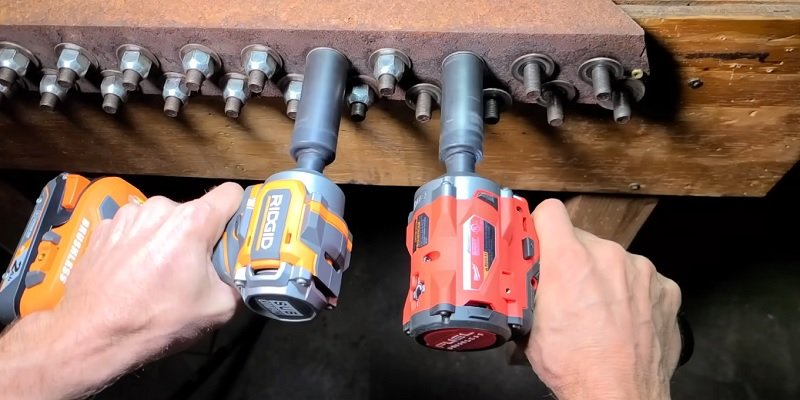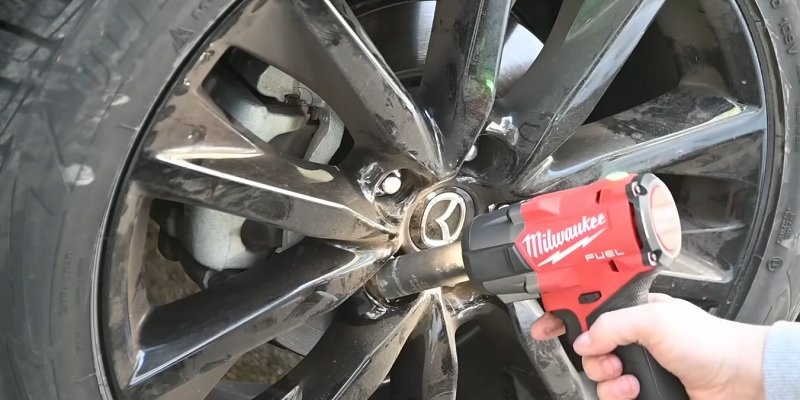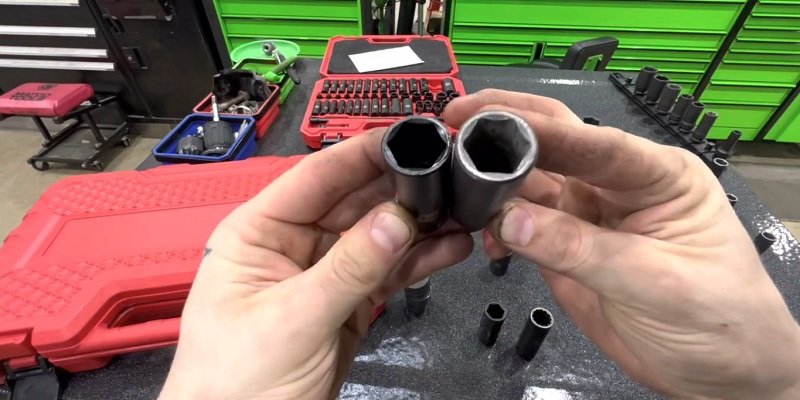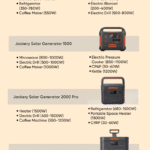Disclosure: This post contains affiliate links and I will be compensated if you make a purchase after clicking through my links. Learn More
1/2 and 3/8 impact wrenches are tools used to tighten or loosen nuts and bolts. They vary in size, with the 1/2 impact wrench being larger and more powerful than the 3/8 impact wrench.
They are both commonly used in automotive and construction industries for different applications. Impact wrenches are essential tools in various industries, particularly in automotive and construction. When it comes to choosing the right impact wrench for your needs, understanding the differences between the 1/2 and 3/8 options is crucial.

We will provide an overview of these two types of impact wrenches, highlighting their variations in size, power, and suitable applications. By the end, you will have a clear understanding of which impact wrench is best suited for your specific projects. So, let’s dive into the comparison of 1/2 vs. 3/8 impact wrenches.
Understanding The Different Sizes And Their Applications
Overview of 1/2 vs 3/8 impact wrenches
Understanding the different sizes and their applications is essential when it comes to choosing the right impact wrench for your needs. In particular, the 1/2-inch and 3/8-inch impact wrenches are two popular options that offer distinct advantages depending on the task at hand. Let’s dive deeper into both sizes and explore their features and applications.
How the size affects power and torque
The size of an impact wrench directly affects its power and torque capabilities. In general, a 1/2-inch impact wrench is larger and more powerful than its 3/8-inch counterpart. The larger size allows for a higher maximum torque output, making it ideal for heavy-duty applications that require extra force to loosen or tighten stubborn bolts or lug nuts.
Read More: What Size Impact Wrench for Lug Nuts
On the other hand, a 3/8-inch impact wrench is smaller and lighter, which offers increased maneuverability in tight spaces. While it may not have the same brute force as a 1/2-inch wrench, it still delivers ample power for most automotive and light-duty tasks. It’s perfect for jobs that require precision, such as working on smaller screws or fasteners.
Features and advantages of each size
1/2-inch impact wrenches have several features that make them preferable for heavy-duty applications. These wrenches typically have a higher maximum torque, enabling them to tackle tougher jobs with ease. They are commonly used in automotive repairs, construction, and industrial settings where more power is required. Additionally, their larger size often translates to better durability and longevity.
On the other hand, 3/8-inch impact wrenches have their own advantages that make them popular for certain tasks. These wrenches are smaller and lighter, making them easier to handle and maneuver. This size is preferred by mechanics and DIY enthusiasts for work on smaller vehicles, motorcycles, and machinery. 3/8-inch wrenches are also commonly used in tasks that require precision and finesse, such as working on delicate or intricate components where excessive torque could cause damage.
Understanding the differences between 1/2-inch and 3/8-inch impact wrenches is crucial for selecting the right tool for your specific needs. Consider the power and torque requirements of your tasks, as well as the space limitations and level of precision required. Ultimately, both sizes have their own unique advantages, and choosing the appropriate one will ensure efficient and effective work.
Comparing Power And Torque
Understanding Power and Torque in Impact Wrenches
When it comes to impact wrenches, one of the most important factors to consider is the power and torque capabilities. Power and torque play a crucial role in determining the effectiveness and efficiency of these tools. In this section, we will compare the power and torque capabilities of 1/2 impact wrenches and 3/8 impact wrenches to help you determine which size is more powerful.
Power and Torque Capabilities of 1/2 Impact Wrenches
1/2 impact wrenches are known for their impressive power and torque capabilities. These powerful tools are typically used in heavy-duty applications that require immense force. With a larger drive size, 1/2 impact wrenches are capable of delivering high levels of torque, making them ideal for tasks such as automotive repairs and construction projects.
The increased power of a 1/2 impact wrench allows it to tackle stubborn nuts and bolts with ease. Whether you’re working on a car engine or loosening tight fasteners, a 1/2 impact wrench provides the strength needed to get the job done efficiently.
Power and Torque Capabilities of 3/8 Impact Wrenches
On the other hand, 3/8 impact wrenches are known for their versatility and compact design. Although they may not possess the same raw power as their 1/2 counterparts, 3/8 impact wrenches offer a great balance between power and maneuverability. These handy tools are perfect for tasks that require a bit of finesse, such as working in tight spaces or handling smaller bolts.
Despite their smaller size, 3/8 impact wrenches still pack a punch when it comes to torque, making them suitable for a wide range of applications. From light automotive repairs to assembling furniture, a 3/8 impact wrench is a go-to choice for both professionals and DIY enthusiasts.
Determining Which Size is More Powerful
You should choose a 1/2 impact wrench or a 3/8 impact wrench ultimately depends on the nature of your intended tasks. If you frequently work on heavy-duty projects that require maximum torque and power, a 1/2 impact wrench is the way to go. However, if you value versatility and maneuverability without compromising on torque, a 3/8 impact wrench will meet your needs.
Consider the specific requirements of your projects and choose the size that aligns with your expectations. Regardless of your choice, both 1/2 and 3/8 impact wrenches offer incredible power and torque capabilities, ensuring that you have the right tool for any job.
Impact Wrench Applications And Uses
Impact wrenches are powerful tools that provide high torque output for various applications. These versatile tools can make fast work of stubborn nuts and bolts, cutting down on manual labor and saving time. When it comes to impact wrenches, two common sizes are 1/2 and 3/8. Understanding the applications and uses of each size can help you select the right tool for your specific needs.
Common applications and industries for 1/2 impact wrenches
In the world of industrial and automotive repair, 1/2 impact wrenches are considered the workhorses. They are ideal for heavy-duty applications that require extra torque. Here are some common applications and industries where a 1/2 impact wrench uses:
- Mechanical maintenance and repair
- Automobile and truck repair
- Construction projects
- Heavy machinery maintenance
- Equipment assembly and disassembly
With its larger size and higher torque output, a 1/2 impact wrench is designed to handle demanding tasks that involve larger fasteners and tougher materials. It’s the go-to tool for professionals in industries that require heavy-duty tightening and loosening.
Common applications and industries for 3/8 impact wrenches
While a 1/2 impact wrench is great for heavy-duty applications, a 3/8 impact wrench is more compact and versatile. It is commonly used for lighter tasks that require precision and accessibility. Here are some common applications and industries where a 3/8 impact wrench shines:
- Automobile and small engine repair
- Electronics assembly
- Furniture assembly
- Plumbing projects
- Home improvement tasks
The 3/8 impact wrench is perfect for jobs that involve smaller fasteners and tight spaces. Its smaller size allows for better maneuverability and control, making it ideal for tasks that require finesse and accuracy.
Matching the size to the specific task or project
Matching the size of the impact wrench to the task or project at hand is crucial for optimal performance. Consider the following factors when choosing between a 1/2 or 3/8 impact wrench:
Size of the fastener: Larger fasteners generally require a 1/2 impact wrench, while smaller fasteners can be handled by a 3/8 impact wrench.
Torque requirements: Heavy-duty tasks that require high torque call for a 1/2 impact wrench, whereas tasks with lower torque requirements can be accomplished with a 3/8 impact wrench.
Accessibility: If the job involves tight spaces or hard-to-reach areas, a 3/8 impact wrench’s smaller size can be more advantageous.
Selecting the right impact wrench for your needs
When selecting the right impact wrench for your needs, it’s essential to consider the specific requirements of your projects. By evaluating factors such as fastener size, torque requirements, and accessibility, you can choose between a 1/2 or 3/8 impact wrench that will enhance productivity and efficiency.
In conclusion, understanding the applications and uses of different impact wrench sizes is crucial for selecting the right tool. Whether you need the power and muscle of a 1/2 impact wrench or the versatility and precision of a 3/8 impact wrench, matching the size to the task at hand will ensure successful outcomes in your projects.
Considerations For DIYers And Professionals
When it comes to choosing the right impact wrench for your projects, whether you are a DIY enthusiast or a professional, there are several factors to consider. The size of the impact wrench and its corresponding drive size, such as 1/2 or 3/8, plays a crucial role in determining the effectiveness and efficiency of your tasks.
Factors to consider for DIY projects with an impact wrench
When taking on DIY projects, it is essential to select the right tools that cater to your specific needs. Here are a few factors to consider when it comes to choosing between a 1/2-inch and a 3/8-inch impact wrench:
Factors to consider for professional use of an impact wrench
For professionals who rely on impact wrenches on a daily basis, having the right tool can make a significant difference in terms of productivity and performance. Here are a few factors to consider when deciding between a 1/2-inch and a 3/8-inch impact wrench for professional use:
Pros and cons of using 1/2 impact wrenches for DIYers
1/2-inch impact wrenches have their advantages and disadvantages when it comes to DIY projects. Let’s take a look at the pros and cons:
Pros
- Provides more power for tackling heavy-duty tasks.
- Offers increased torque, making it easier to remove stubborn bolts and nuts.
- Compatible with larger fasteners and sockets.
Cons
- Can be bulkier and heavier, making them less maneuverable in tight spaces.
- May generate more vibration, leading to increased fatigue during extended use.
- Not always necessary for lighter DIY projects.
Pros and cons of using 3/8 impact wrenches for DIYers
On the other hand, 3/8-inch impact wrenches also have their own set of advantages and disadvantages for DIYers:
Pros
- Compact and lightweight, allowing for greater maneuverability in tight spaces.
- Less vibration, reducing fatigue during prolonged use.
- More suitable for lighter DIY tasks where excessive power may not be required.
Cons
- May struggle with heavy-duty applications.
- Less torque compared to 1/2-inch impact wrenches, making it harder to tackle stubborn bolts or nuts.
- Smaller drive size limits compatibility with larger fasteners and sockets.
Pros and cons of using 1/2 impact wrenches for professionals
Professionals often require the utmost reliability and power from their tools. Here are the pros and cons of using a 1/2-inch impact wrench in professional settings:
Pros for professionals
- Offers maximum power and torque, ideal for heavy-duty applications.
- Compatible with a wide range of fasteners and sockets.
- Efficiently tackles stubborn bolts and nuts.
Cons for professionals
- Can be more cumbersome and heavy, possibly hindering maneuverability in tight spaces.
- May produce more vibration, leading to increased fatigue during prolonged use.
- Not always necessary for tasks that require less power or torque.
Pros and cons of using 3/8 impact wrenches for professionals
Finally, let’s examine the pros and cons of using a 3/8-inch impact wrench in professional settings:
Pros for professionals
- Compact and lightweight design allows for enhanced maneuverability.
- Reduced vibration minimizes fatigue during extended use.
- More suitable for tasks that do not demand excessive power.
Cons for professionals
- May struggle with heavy-duty applications.
- Less torque compared to 1/2-inch impact wrenches, making it challenging to handle stubborn bolts or nuts.
- Limitations in compatibility with larger fasteners and sockets.
Consider these factors, pros, and cons carefully to make an informed decision when choosing between a 1/2-inch and a 3/8-inch impact wrench. Ultimately, your choice will depend on the specific needs of your DIY projects or professional tasks.
Making An Informed Decision
When it comes to choosing the right impact wrench for your needs, it’s important to make an informed decision. The two most common sizes are the 1/2 and 3/8 impact wrenches, each with its own set of advantages and considerations.
Now, we will explore the key factors to consider when choosing between these two sizes, helping you find the right balance between power and versatility that matches your specific needs and requirements. We will also take a look at personal experiences and recommendations from experts to provide you with valuable insights.
Key factors to consider when choosing between 1/2 and 3/8 impact wrenches
When selecting the right impact wrench size, there are several factors that you should keep in mind:
Power requirements
If you frequently work with heavy-duty applications or large bolts, a 1/2 impact wrench may be more suitable due to its higher torque output. On the other hand, if you mainly work with light to medium-duty tasks, a 3/8 impact wrench can provide sufficient power without being too bulky or overwhelming.
Versatility
Consider the range of fasteners you will be working with. A 3/8 impact wrench is ideal for smaller fasteners and applications such as automotive repairs, while a 1/2 impact wrench can handle a wider variety of tasks, including larger bolts and heavy equipment repairs.
Tool weight and size
Size and weight are important considerations, especially if you will be using the impact wrench for extended periods. A 3/8 impact wrench is generally lighter and more compact, making it easier to maneuver in tight spaces. A 1/2 impact wrench, on the other hand, may provide more stability and leverage for demanding applications.
Compatibility
Check your existing socket set or the sockets you plan to purchase to ensure they match the desired impact wrench size. It’s important to have the right sockets that fit securely onto the anvil of your impact wrench, as mismatched sizes can result in slippage and reduced efficiency.
Finding the right balance between power and versatility
Choosing between a 1/2 and 3/8 impact wrench essentially comes down to finding a balance between power and versatility. Assess the nature of your work and the specific tasks you will be performing most frequently. If you primarily work on small to medium-sized fasteners, a 3/8 impact wrench may be the more practical choice. However, if you also handle larger bolts and heavy-duty applications, a 1/2 impact wrench can offer the necessary power to get the job done.
Understanding your specific needs and requirements
Before making a decision, take the time to thoroughly understand your specific needs and requirements. Consider the types of projects you will be working on, the materials you will be dealing with, and the level of torque and power you will need. This knowledge will help you make an informed decision and select the impact wrench size that will best suit your needs.
Personal experiences and recommendations from experts
From our experts can offer valuable insights when it comes to choosing between a 1/2 and 3/8 impact wrench. Reach out to experienced mechanics, contractors, or professionals in your industry for their input and recommendations. Additionally, online forums and product reviews can provide a wealth of information from individuals who have hands-on experience with various impact wrench sizes.
Remember that everyone’s needs may vary, and what works for someone else may not necessarily work for you. Take into account the advice and experiences of others, but ultimately trust your own judgment and prioritize your specific requirements.
Final thoughts on selecting the best impact wrench size for you
Choosing between a 1/2 and 3/8 impact wrench requires careful consideration of the key factors mentioned earlier. Assess your power requirements, consider the versatility needed for your projects, and understand the specific needs and requirements of your work. Seek input from experts and individuals with personal experiences, but ultimately trust your own judgment. By doing so, you can make an informed decision and select the best impact wrench size that will serve you well in your professional or DIY endeavors.
Frequently Asked Questions For 1/2 Vs 3/8 Impact Wrench
Which Is Better A 3/8 Or 1/2 Impact Wrench?
The 3/8 impact wrench is better for smaller tasks, while the 1/2 impact wrench is more powerful and suitable for larger jobs. Choose based on your specific needs and the size of the projects you’ll be working on.
What Is The Best Size Impact Wrench To Get?
The best size impact wrench to get depends on your needs and the tasks you have. Consider the torque required for your applications and choose a size that meets those requirements. It’s important to pick a size that provides enough power without being too heavy or bulky to handle comfortably.
Is A 3/8 Impact Wrench Good For Lug Nuts?
Yes, a 3/8 impact wrench is suitable for lug nuts.
Do I Need A 3/8 Or 1/2 Inch Torque Wrench?
You may need both a 3/8 and a 1/2 inch torque wrench for different applications. The 3/8 inch is suited for smaller bolts and automotive work, while the 1/2 inch is for heavier duty tasks like mechanical repairs. So, the choice depends on the specific needs of your projects.
Wrapping Up
The choice between a 1/2 and 3/8 impact wrench ultimately depends on your specific needs and the tasks you will be tackling. Consider factors such as torque requirements, the type of work you will be doing, and the size of fasteners you will be working with.
By carefully evaluating these factors, you can make an informed decision that will enhance your performance and efficiency in your projects. So, choose wisely and get the job done effortlessly!








